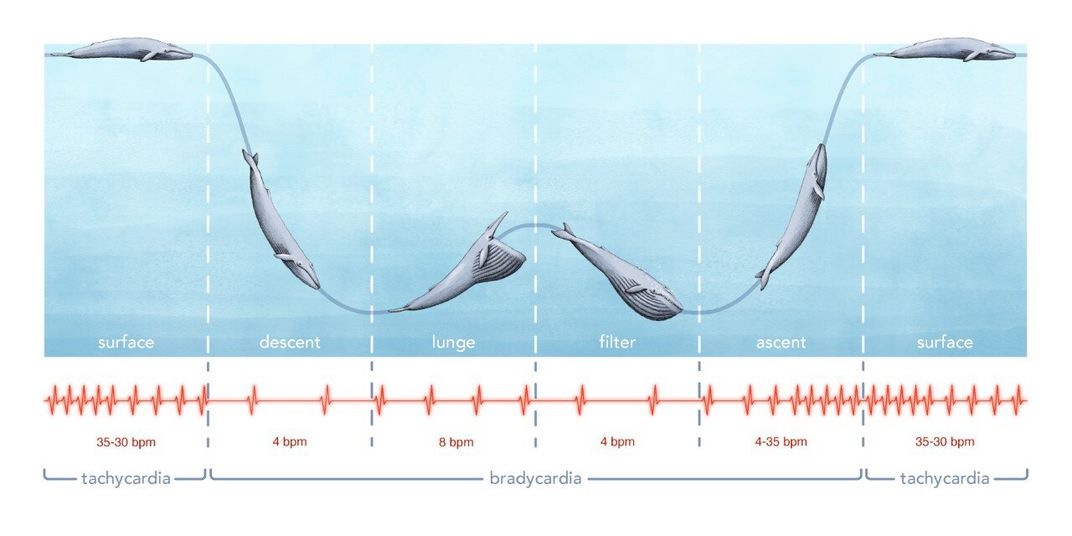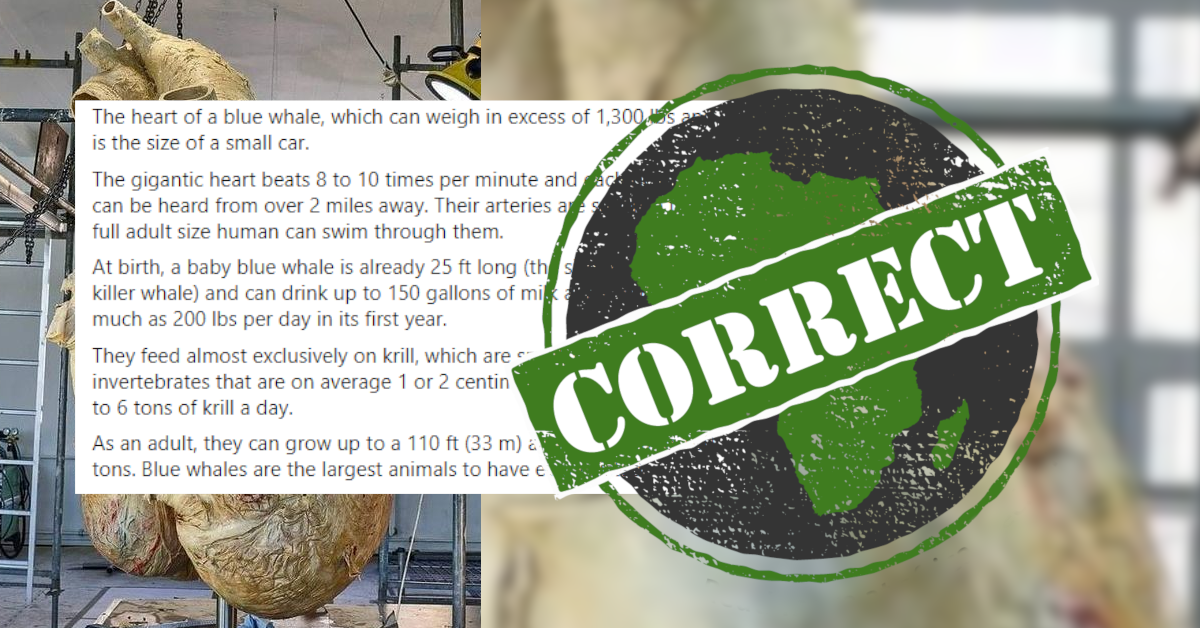A photo circulating on Facebook in South Africa shows what looks like a large animal organ on display, suspended by chains above the floor with a spotlight trained on it.
The photo’s caption says this is the heart of a blue whale. “The heart of a blue whale, which can weigh in excess of 1,300 lbs [590 kilograms] and is the size of a small car.”
The post makes several other claims about blue whales:
These are impressive claims about blue whales, but Facebook’s fact-checking system has flagged them as possibly false.

According to Britannica, the blue whale – also called the sulphur-bottom whale – is “the most massive animal ever to have lived”. It weighs about 150 tonnes and may grow longer than 30 metres.
The photo of the extremely large organ shared on Facebook is of a whale heart that was on display in the Royal Ontario Museum (ROM) in Toronto, Canada, in 2017.
In a press release at the time, the museum said: “The ROM’s specimen ... is the first and only real preserved blue whale heart in the world.”
CBC, a Canadian news organisation, published a video of the heart being offloaded at the museum.
“Its sheer size alone accelerates decomposition, so it’s remarkable we got to salvage a heart,” Jacqueline Miller, who led the preservation effort at ROM, told Wired magazine.
But just how big is a blue whale’s heart? The Whaling Museum and Education Center in Cold Spring Harbor in the US says that the animal’s heart can weigh up to 181 kilograms.
Does this make it the size of a small car? Not exactly. The museum says the heart “wasn’t as big as a Volkswagon – more like a small golf cart”.
A whale’s heartbeat per minute depends on what the whale is doing. The whaling museum says “a blue whale’s heartbeat slows dramatically during dives to over 1,000 feet”, or 300 metres, slowing to four to eight beats a minute. It has “an extreme low of only two beats, a drastic measure to save oxygen”.
An illustration in the Smithsonian magazine shows a whale’s heartbeat based on its activity.

And are a whale’s arteries really so big that “a full adult size human can swim through them”? According to BBC Earth, the whale’s heart on display at the ROM had smaller arteries than was previously thought. They were “probably capable of fitting a human head inside”, but not an adult human.
Baby blue whales, known as calves, “enter the world already ranking among the planet's largest creatures”, says National Geographic.
After spending a year in their mother’s womb, a blue whale calf is born weighing up to 3 tonnes with a length of about 7 metres.
Calves eat “nothing but mother's milk and gain about 200 pounds [91 kilograms] every day for its first year”, says National Geographic.
The nonprofit organisation Future Oceans has also confirmed that the calves can drink up to 570 litres of milk a day, as is claimed on Facebook.
Do blue whales really eat up to 5 tonnes of krill a day?
The National Marine Fisheries Service, an office of the National Oceanic and Atmospheric Administration in the US, says that the primary diet of blue whales is krill. But whales also eat fish and copepods, or small crustaceans, according to the office.
“When blue whales hunt for food, they filter feed by swimming toward large schools of krill with their mouth open, then push the water out of their mouth with their tongue while keeping the krill trapped inside their baleen plates.”
The Marine Mammal Center in the US says blue whales can eat up to 5 tonnes of krill a day.
Guinness World Records also claim the blue whale is the largest animal on Earth based on weight, weighing up to 160 tonnes.
National Geographic says blue whales are “the largest animals that have ever lived”, and that they are “even bigger than dinosaurs”.
The Whale and Dolphin Conservation, or WDC, a wildlife charity partnered with the United Nations Environment Programme, also confirm that the blue whale is larger than any of the dinosaurs that have been recorded.
According to the WDC, an “average blue whale weighs 14 tonnes or as much as 25 adult African elephants”.
The blue whale facts circulating on Facebook may sound astounding, but they are largely accurate. – Taryn Willows
The photo’s caption says this is the heart of a blue whale. “The heart of a blue whale, which can weigh in excess of 1,300 lbs [590 kilograms] and is the size of a small car.”
The post makes several other claims about blue whales:
- “The gigantic heart beats 8 to 10 times per minute and each heartbeat can be heard from over 2 miles [3 kilometres] away. Their arteries are so large that a full adult size human can swim through them.”
- “At birth, a baby blue whale is already 25 ft [8 metres] long (the size of an adult killer whale) and can drink up to 150 gallons [568 litres] of milk a day and gain as much as 200 lbs [91 kilograms] per day in its first year.”
- “They feed almost exclusively on krill, which are small, shrimp-like invertebrates that are on average 1 or 2 centimeters long. They eat 4 to 6 tons [3.5 to 5 metric tonnes] of krill a day.”
- “As an adult, they can grow up to a 110 ft (33 m) and weigh up to 180 tons [163 metric tonnes]. Blue whales are the largest animals to have ever existed.”
These are impressive claims about blue whales, but Facebook’s fact-checking system has flagged them as possibly false.

400-pound heart, though not as big as ‘small car’
According to Britannica, the blue whale – also called the sulphur-bottom whale – is “the most massive animal ever to have lived”. It weighs about 150 tonnes and may grow longer than 30 metres.
The photo of the extremely large organ shared on Facebook is of a whale heart that was on display in the Royal Ontario Museum (ROM) in Toronto, Canada, in 2017.
In a press release at the time, the museum said: “The ROM’s specimen ... is the first and only real preserved blue whale heart in the world.”
CBC, a Canadian news organisation, published a video of the heart being offloaded at the museum.
“Its sheer size alone accelerates decomposition, so it’s remarkable we got to salvage a heart,” Jacqueline Miller, who led the preservation effort at ROM, told Wired magazine.
But just how big is a blue whale’s heart? The Whaling Museum and Education Center in Cold Spring Harbor in the US says that the animal’s heart can weigh up to 181 kilograms.
Does this make it the size of a small car? Not exactly. The museum says the heart “wasn’t as big as a Volkswagon – more like a small golf cart”.
Heartbeat varies
A whale’s heartbeat per minute depends on what the whale is doing. The whaling museum says “a blue whale’s heartbeat slows dramatically during dives to over 1,000 feet”, or 300 metres, slowing to four to eight beats a minute. It has “an extreme low of only two beats, a drastic measure to save oxygen”.
An illustration in the Smithsonian magazine shows a whale’s heartbeat based on its activity.

And are a whale’s arteries really so big that “a full adult size human can swim through them”? According to BBC Earth, the whale’s heart on display at the ROM had smaller arteries than was previously thought. They were “probably capable of fitting a human head inside”, but not an adult human.
Oh, baby
Baby blue whales, known as calves, “enter the world already ranking among the planet's largest creatures”, says National Geographic.
After spending a year in their mother’s womb, a blue whale calf is born weighing up to 3 tonnes with a length of about 7 metres.
Calves eat “nothing but mother's milk and gain about 200 pounds [91 kilograms] every day for its first year”, says National Geographic.
The nonprofit organisation Future Oceans has also confirmed that the calves can drink up to 570 litres of milk a day, as is claimed on Facebook.
What’s on the menu for blue whales?
Do blue whales really eat up to 5 tonnes of krill a day?
The National Marine Fisheries Service, an office of the National Oceanic and Atmospheric Administration in the US, says that the primary diet of blue whales is krill. But whales also eat fish and copepods, or small crustaceans, according to the office.
“When blue whales hunt for food, they filter feed by swimming toward large schools of krill with their mouth open, then push the water out of their mouth with their tongue while keeping the krill trapped inside their baleen plates.”
The Marine Mammal Center in the US says blue whales can eat up to 5 tonnes of krill a day.
Largest animals ever?
Guinness World Records also claim the blue whale is the largest animal on Earth based on weight, weighing up to 160 tonnes.
National Geographic says blue whales are “the largest animals that have ever lived”, and that they are “even bigger than dinosaurs”.
The Whale and Dolphin Conservation, or WDC, a wildlife charity partnered with the United Nations Environment Programme, also confirm that the blue whale is larger than any of the dinosaurs that have been recorded.
According to the WDC, an “average blue whale weighs 14 tonnes or as much as 25 adult African elephants”.
The blue whale facts circulating on Facebook may sound astounding, but they are largely accurate. – Taryn Willows
Republish our content for free
For publishers: what to do if your post is rated false
A fact-checker has rated your Facebook or Instagram post as “false”, “altered”, “partly false” or “missing context”. This could have serious consequences. What do you do?
Click on our guide for the steps you should follow.
Publishers guideAfrica Check teams up with Facebook
Africa Check is a partner in Meta's third-party fact-checking programme to help stop the spread of false information on social media.
The content we rate as “false” will be downgraded on Facebook and Instagram. This means fewer people will see it.
You can also help identify false information on Facebook. This guide explains how.


Add new comment